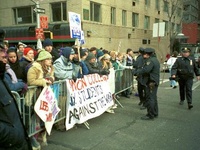“This is freedom at work,” she said of the protests. “This is what it’s all about, there’s nothing wrong with that...We understand their position, they understand ours; we’re trying to work together.”
Upper East Side resident Cathy Kos said she was not participating in the protest, but thought the city had handled the crowd-control poorly.
“This better be a message to the city,” she said. “Because if there’s a war there are only going to be more rallies like this.”
Instead of following the designated path, many protesters formed miniature demonstrations of their own, with groups of several hundred marching up and down Second and Third Avenues.
At the rally site, famous peace advocates such as South African Anglican Arch-Bishop Desmond Tutu, actress Susan Sarandon and Martin Luther King III spoke out against the war.
Folk singers Pete Seeger and Harry Belafonte also performed for the crowd under a banner that read, “The world says no to war.”
Handheld radios broadcast the performance to the sea of people that stretched 20 blocks up First Avenue.
Other protesters danced and sang to the rhythmic pounding of bongo drums—and makeshift musical instruments—that some protesters played as they pressed forward towards the stage.
Thousands of police officers patrolled the city blocks in an effort to keep the protest under control.
The city stationed sharpshooters on building roofs around the U.N. and used bomb-sniffing dogs as a precaution against terrorism.
Security concerns were the grounds on which a federal court denied United for Peace and Justice—the umbrella group that planned the event—a permit to march on Saturday.
But despite the decision, protesters still marched near Times Square, continuing their chants.
The protest was mostly peaceful. The New York Police Department said they made 257 arrests.
HIPJ members said they thought the rally was a success despite what they described as an overbearing police presence.
“I was really impressed by the magnitude of the people who turned out and their persistence to rally despite the police presence and their ability to not get into conflict,” said Paul G. Dexter ’03, a member of HIPJ.
“As for Harvard, I would say it was definitely a success for the movement,” said Michael Fournier, an employee in the Registrar’s Office and one of the organizers of the trip. “We hope to continue our success into the future.”
Fournier said HIPJ—which was founded on September 11, 2001, to oppose a violent response from the U.S. government to the terrorist attack— is also planning a walk-out from classes if the U.S. goes to war against Iraq.
–Staff writer Nathaniel A. Smith can be reached at nsmith@fas.harvard.edu.









